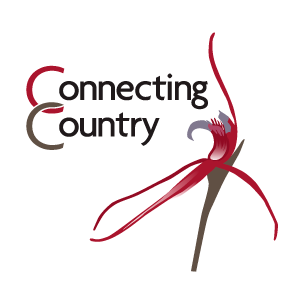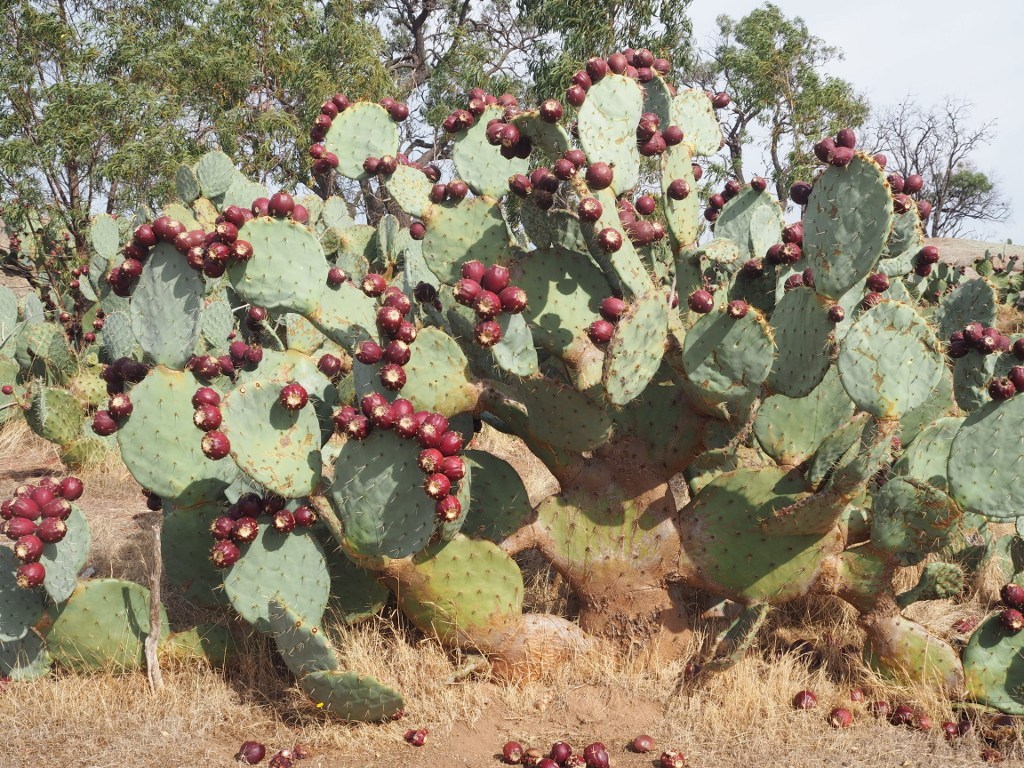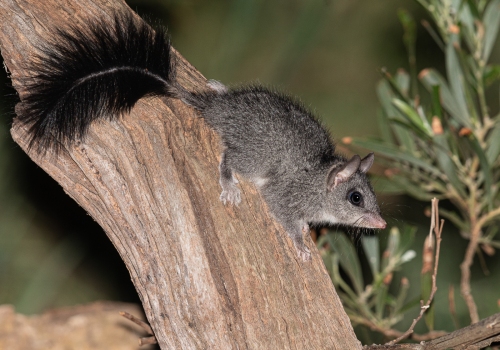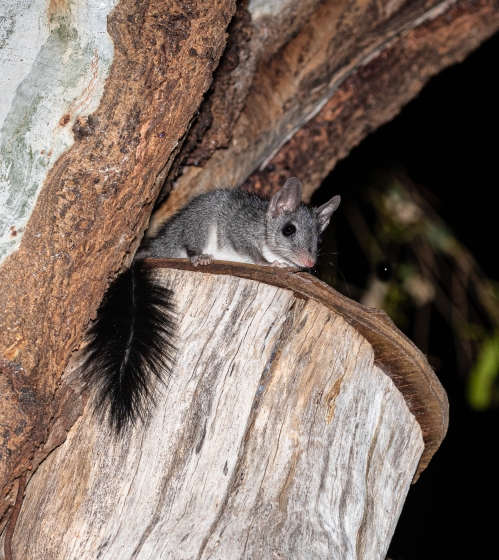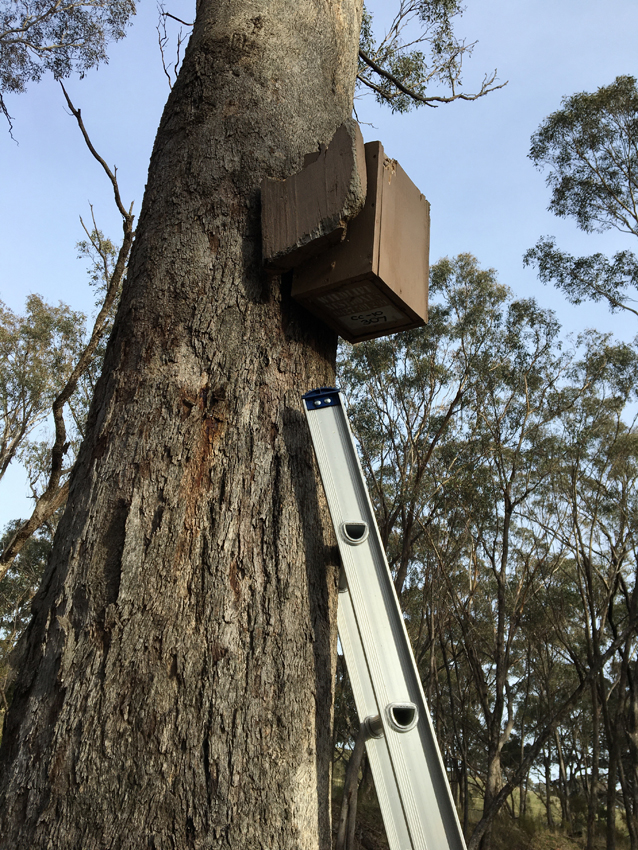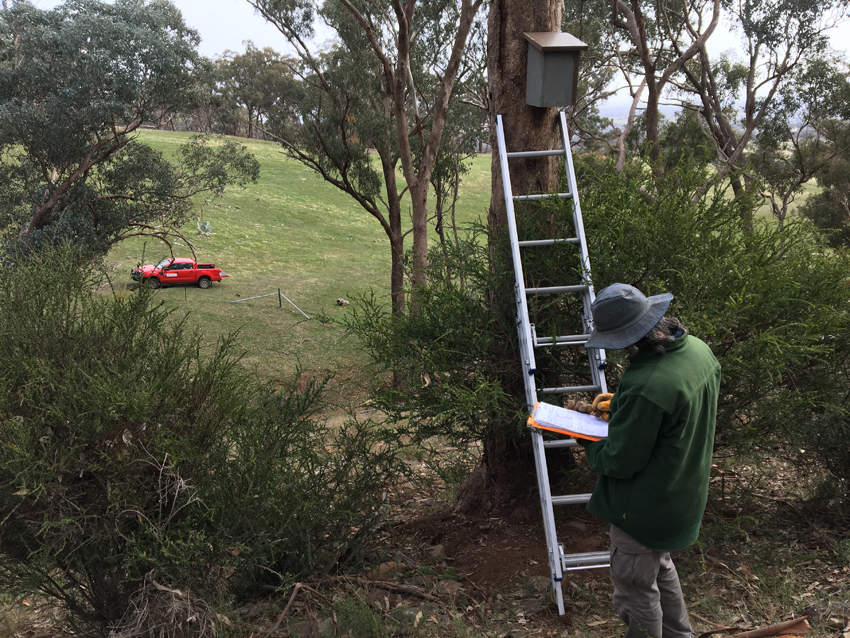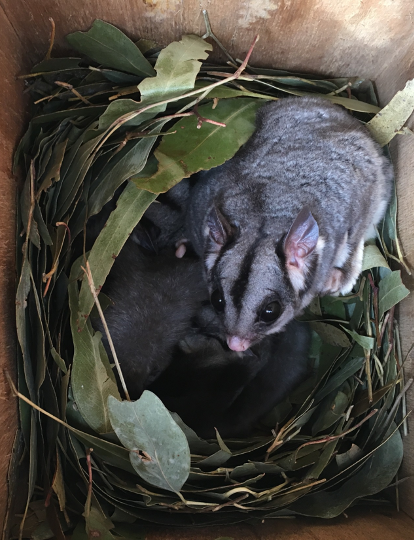Seeking contractor expressions of interest for planting
Posted on 31 March, 2022 by Jess
Connecting Country is seeking to expressions of interest for a contractor to plant 1,000 tubestock plants across two properties in the Mount Alexander region of central Victoria around June 2022.
This project requires careful location and labelling of the plants so that each plant can be tracked and monitored into the future. Each plant will be protected by a wire guard.
If you are interested, please contact info@connectingcountry.org.au by Monday 18 April 2022.
Please provide us with the following information:
- Your schedule of rates.
- How many plants you usually plant in a day.
- When you are available to plant the plants.
- Your experience with similar projects.
We look forward to hearing from you!
Thank you for donating to Tiny houses for Tuans!
Posted on 31 March, 2022 by Jess
We are so grateful to everyone who has donated to our recent campaign to raise funds for nest boxes. Thanks to you, we have just placed an order for 60 tuan nest boxes with our friends at Wildlife Nestboxes.
A huge thank you to our Tiny Houses for Tuans donors: Adam Purcell, Bergen O’Brien, Brendan Sydes, Bridget Farmer, Bronwen Algate, Carolyn White, Chris Lawrence, Elle Fox, Geoffrey Sutter, Jane Rusden, Jennifer Rolland, Jessica Seidel, John Carruthers, Lesley Carlin, Lisa Rowe, Maree Cheesman, Michelle Hanslow, Patricia Robins, Petra Fischer, Philip Hopley, Smiley Williams, Stuart Brown, and 12 other anonymous donors who generously contributed to the project.
Receiving donations like this means a lot to us here at Connecting Country. It helps us practically – we would not have been able to replace these nest boxes without your support – but it also warms our hearts and lightens our outlook for the future. On behalf of our staff, nest box volunteers, and of course, the Tuans – thank you!
Don’t forget, here are some other ways you can help threatened Tuans:
- Keep pets, especially cats (known predators of phascogales), indoors at night when Tuans are active.
- Retain leaf litter, logs, and trees (especially mature trees) on your property, as these provide foraging and den resources for tuans.
- Provide your own ‘Tiny Houses’ by installing nest boxes on your property. To contact a local provider, Wildlife Nestboxes – click here
- Contribute to restoring healthy forests by joining your local Landcare or Friends group. To find a group – click here
- Consider volunteering to monitor nest boxes with Connecting Country (next surveys in autumn 2022). To register your interest – email jess@connectingcountry.org.au
- Share our campaign with your friends and networks.
Agriculture Victoria workshop on wheel cactus – 7 April 2022
Posted on 31 March, 2022 by Frances
Our friends and neighbours at Loddon Plains Landcare Network (LPLN) are promoting a new Wheel cactus workshop and opportunity to learn more about managing this prickly weed. Please read on for details.
Agriculture Victoria is conducting a Wheel cactus workshop next Thursday 7 April 2022 in Buckrabanyule (near Wedderburn) VIC.
In recent years, it is apparent that landholders and groups are spending more time than ever managing for this weed. The community understands the very real threat that Wheel cactus presents and, given its severity and terrible invasiveness, LPLN encourages all members and residents to attend and provide your voice of support to provide on-ground action and management against this weed.
LPLN will be in attendance and plans to present its proposal of the formation of a community-led Wheel Cactus Management Taskforce, providing community support and development of a Regional Management and Action Plan.
For more information please refer to the event flyer – click here
Bird of the month: Common Bronzewing
Posted on 29 March, 2022 by Ivan
Welcome to our 23rd Bird of the month, a partnership between Connecting Country and BirdLife Castlemaine District. Each month we’re taking a close look at one special local bird species. We’re excited to join forces to deliver you a different bird each month, seasonally adjusted, and welcome suggestions from the community. We are lucky to have the talented and charismatic Jane Rusden from BirdLife Castlemaine District, and the brilliant Damian Kelly, sharing their writing and images about our next bird of the month.
Common Bronzewing (Phaps chalcoptera)
This month we are looking at the Common Bronzewing, simply because they are resident at my place and are really quite odd! Regularly seen foraging and using the bird baths, for such a flighty shy bird, they have become quite used to us. It was a female having a prolonged bathe, for about 20 minutes, that drew my attention. She sat low in the water and rolled on her side, wing in the air (see photo), having a good soak, as if having a luxury spa. Pedicure next? I’ve seen Emus do similar, but they are enormous with such crazy long legs, so what else are they going to do? Common Bronzewings also clap, not so much in applause, but when flushed. They will usually fly from the ground up into a tree. As they take off, they clap their wings a few times, and once landed, will bob their heads as they look at you from a safe perch.
The Common Bronzewing is exactly as its name suggests, having bronze colours under the wing and being common throughout most of Australia from coasts to the Mallee. However, they were not always common as they were once illegally shot for food and sport. Thankfully, now they are easily found in Central Victoria, favouring wooded areas. They can also be found in suburban gardens, which is an indication of their adaptability. Their diet consists mainly of seeds, with occasional leaves and invertebrates. I see the resident ‘Bronzies’ foraging on the ground or in low bushes, singularly or in groups of two or three, mostly in the morning or at dusk. They visit my bird baths for a drink, most often at dawn or early morning and dusk. This is typical behaviour for the species.
Although not the only bird to compete in the scrappiest nest award, they are up there with the best. There’s a considerable pile of fine Casuarina twigs on the ground that I need to sweep up, which is the remains of a nest building attempt on top of the fire shutter housing above our windows. There’s far more twigs on the ground than ever makes it into their questionable nest building. In fact eggs roll out on a regular basis. I often carry on about how intelligent birds are, but I’m not so convinced when it comes to Bronzies. Don’t tell anyone I said that about a bird!
However, when the iridescent patch on their wings lights up, throwing flashes of golden yellow through teal green, magenta and purple colours, they are quite stunning and majestic. Their soft pinky brown chests, grey upper body and creamy white forehead on the males set off their bright pink feet beautifully. They can be easily confused with the darker and less iridescent Brush Bronzewing, which can be see along Forest Creek on occasion. Also confusing is their deep booming call, with repeated long notes that can easily be confused with the Painted Button-quail, who favours the same habitat. Damian and I have nearly confused them when heard in Kalimna Park, for example.
There’s a lot to say about this beautiful species. They fly quite fast, with speed measured from vehicles at 58-60 km/hour, and a maximum of 67 km/hour. Movement in response to food and water availability is a regular occurrence for at least part of the population, with distances up to 360 km being recorded.
Another fun fact about the Common Bronzewing is they can safely feed on Gastrolobium bilobum, commonly known as heart-leaved poison, which is a highly toxic plant common in western and northern Australia. This may explain why, in at least some areas, they are not particularly hunted by cats and dogs, who would normally find a largely ground dwelling bird easy prey.
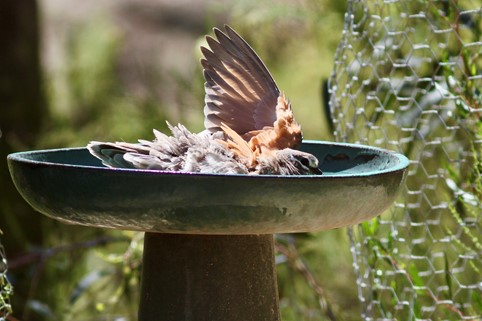
Female Common Bronzewing lying on its side and having a good soak in a bird bath (photo by Jane Rusden)
Jane Rusden
BirdLife Castlemaine District
Update on Tiny Houses for Tuans
Posted on 16 March, 2022 by Jess
We are so, so grateful to our amazing community!
We are delighted to announce that we received a total of $5,000 in donations in the first five days of our ‘Tiny Houses for Tuans’ fundraising campaign! At the time of writing, we are only $311 away from reaching our goal of raising $6,000 to replace 60 broken nest boxes for our long-term Tuan nest box project.
To read more about this project – click here
The Tuan (also known as the Brush-tailed Phascogale) is a very cute hollow-dependent marsupial carnivore that can easily be identified by its characteristic black brushy tail. Phascogales eat mainly invertebrates, and forage for food on and under the bark of trees, on logs, and in leaf litter on the ground. They have an extraordinary life history – all males die from stress following their first breeding season before they reach one year of age. This threatened species is in decline in Victoria and has undergone substantial range contractions and regional extinctions. Key threats include predation by cats and foxes, climate change and drought, habitat removal and degradation, and the extensive loss of trees with hollows. Recent research has highlighted that the Mount Alexander region is a stronghold for tuans and is important for the future conservation of this species.
To make a donation and contribute to this project – click here
Can’t donate? Here are some other ways you can help threatened tuans:
- Keep pets, especially cats (known predators of phascogales), indoors at night when tuans are active
- Retain leaf litter, logs, and trees (especially mature trees) on your property, as these provide foraging and den resources for tuans
- Provide your own ‘Tiny Houses’ – consider installing nest boxes on your property
- Contribute to restoring healthy forests by joining your local Landcare or Friends group. To find a group – click here
- Consider volunteering on Connecting Country’s monitoring project (next surveys in autumn 2022) – email jess@connectingcountry.org.au to register your interest
- Share our campaign with your friends and networks.
Join us ‘Bird walk for beginners’ launch – 6 April 2022
Posted on 16 March, 2022 by Ivan
Come and help us celebrate the launch of our new brochure and bird walk, ‘Bird walk for beginners’, an easy walk along Leanganook Track and Forest Creek in Castlemaine VIC. The event and bird walk brochure aim to attract new birdwatchers, as well as celebrate the excellent restoration work that volunteers have achieved over the past few decades along Forest Creek. Bird walks are an ideal way to get people out enjoying and exploring the many natural assets we are blessed with here in central Victoria.
Bird watching is a great activity that almost everyone can enjoy, and this walk aims to increase the accessibility of bird walking in our region. We also feature a video of the walk presented by some engaging local bird enthusiasts, providing an in-depth view of the walk features for those less-abled or unable to visit the walk in-person. The COVID-19 lockdown period has seen a ten-fold increase in the number of new birdwatchers around the country, with a similar trend here in central Victoria. People are craving nature and the outdoors, prompting them to start their bird watching journey and enjoy the challenges of how to differentiate some of the trickier species.
Join us for a short, guided bird walk for all ages and abilities, and explore our new ‘Bird walk for beginners’ brochure, featuring QR codes to access bird and habitat information. The brochure launch event will feature a walk with local experts from BirdLife Castlemaine, Castlemaine Landcare Group and Castlemaine Field Naturalists Club, and will highlight the excellent volunteer work along this section of Forest Creek and Leanganook Track.
The walk is approximately 1.5 km long and is located along a gently graded, well-maintained walking path.
We will stop at eight sites along the bird walk, providing excellent opportunities to visit some great bird watching spots, with experienced mentors to guide you through the morning. Participants will have a chance to ask questions and learn directly from mentors, and scan the QR codes in the brochure to learn more about the birds at each site.
When: Wednesday 6 April 2022 at 11.00 am
Where: Leanganook Track, corner of Colles Rd and Murphy St, Castlemaine VIC. To view a google map link – click here
Bookings: Bookings are essential and tickets are limited. To book please – click here
This event is part of our ‘Birding for beginners’ project supported by the Victorian Government through Parks Victoria’s Volunteering Innovation Fund.
Please bring water and clothes for all weather to the walk, as you never know what autumn conditions may bring. All participants must adhere to health and safety requirements, including any current COVID-19 restrictions Please wear appropriate clothing and footwear and bring water and snacks, as well as binoculars if you have some. Connecting Country will provide some extra binoculars to share if needed.
Bird watching is one of the most enjoyable and satisfying ways to enjoy our natural heritage. Recording your bird observations also contributes valuable data for scientific research and informed conservation decisions. Birds are often our key connection to the landscape. They are prevalent in most environments and tell us much about our surroundings and environmental health. Central Victoria is considered a birding hotspot and they often prompt you to explore wonderful places that you never knew existed!
Connecting with the land: ‘Our arid bush paradise’
Posted on 10 March, 2022 by Ivan
Reconnecting with our local landscape has been a common theme over the past few years, especially during COVID-related lockdowns and restrictions. In many ways, we were left with little choice but to connect with places close to home, or in many cases, our own backyards.
Connecting with nature and our surrounding landscape has proved to be vital during times of stress, anxiety and uncertainty, and has proven links to mental health and feelings of belonging. Nature can generate a multitude of positive emotions, such as calmness, joy and creativity and can facilitate concentration.
We recently discovered a great blog post that does a lovely job of summarising the joys and challenges of connecting with our landscape, from a perspective of a landholder and farmer in the Mount Alexander region. The article was written by Katie Finlay at Harcourt Organic Food Co-op. Katie and Hugh’s farm has been part of several Connecting Country projects over the years, and provides an inspiring demonstration of sustainable land management.
Please enjoy Katie’s article below, courtesy of the Grow Great Fruit blog. To visit the blog – click here
Our arid bush paradise
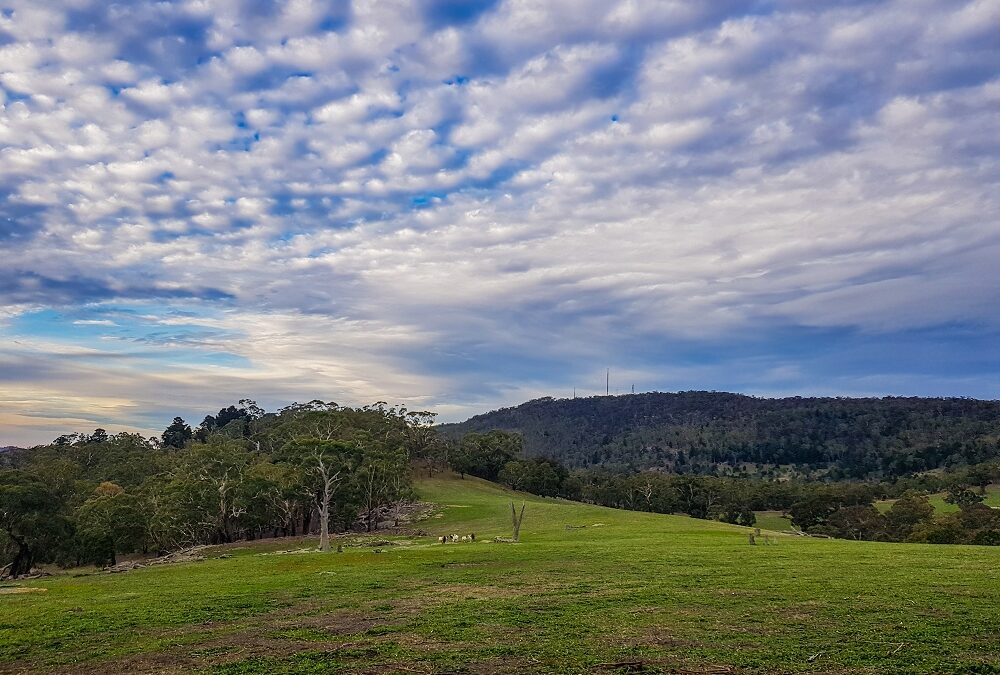
We live in a pretty arid part of the world, but living through the COVID-19 era, we’ve come to appreciate our landscape in new ways.
We live on Dja Dja Wurrung land, on the side of the small but majestic Leanganook. That’s the Dja Dja Wurrung name for Mount Alexander, and it means ‘his teeth’. You can watch this short video to find out more about the significance of the name.
Our farm borders the Leanganook (Mount Alexander) Regional Park, so our backyard is pretty big.
We go for a lot of walks on the mountain, and it’s always spectacular and calming. During lockdowns, we (and everyone else) weren’t able to leave home, so we spent even more time than usual in the bush.
Sharing our backyard with you
If you live in the city or a regional town it can be hard enough at the best of times to get into wild nature.
We know from first-hand experience that being in the bush is incredibly good for the soul. Even though photos are a poor substitute for the actual smells, sounds, and feel of being in the bush, the least we can do is share our walks with you.
So, here’s a couple of our favourite trees we visit regularly.
They have a way of reducing us to instant insignificance on the planet and putting any niggling worries into perspective.
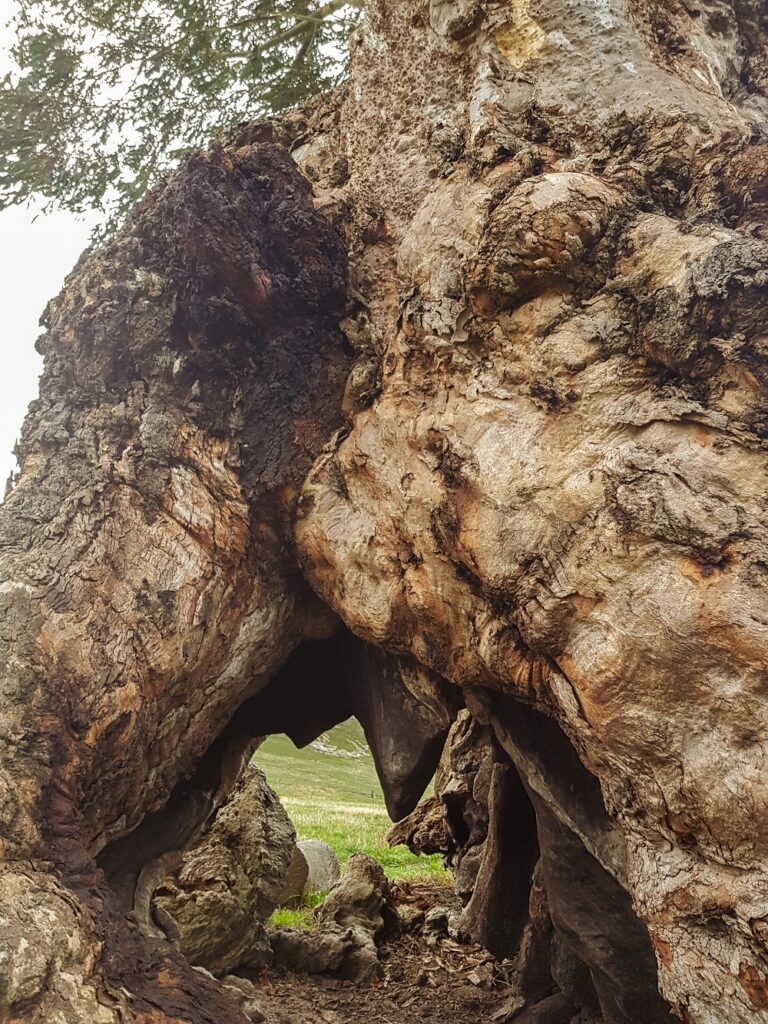
Just being in their presence makes us wonder how long these trees have been here.
Who have they sheltered? What storms have they weathered? Who (and what) has wandered past in the last couple of hundred years?
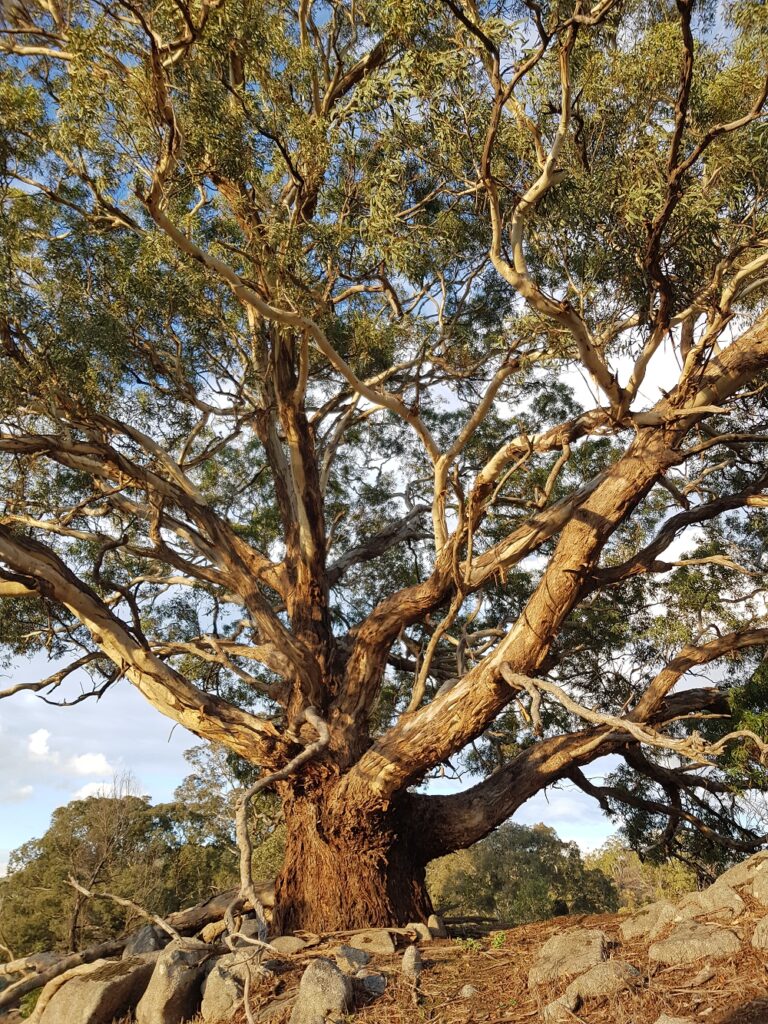
Granite bones
Our mountain is made of granite. Apart from providing the mineralisation that makes this region such a great place to grow fruit, it’s also a beautiful stone.
Granite stone formations can be huge, with lots of mysterious cracks and crevices. Granite doesn’t form caves as such, but it’s not at all unusual to find openings big enough to imagine someone or something seeking shelter inside at some time in history.
We always keep clear of the rocks. It feels like an invasion of privacy to poke about too closely, so we keep a respectful distance from their mysterious inner life.
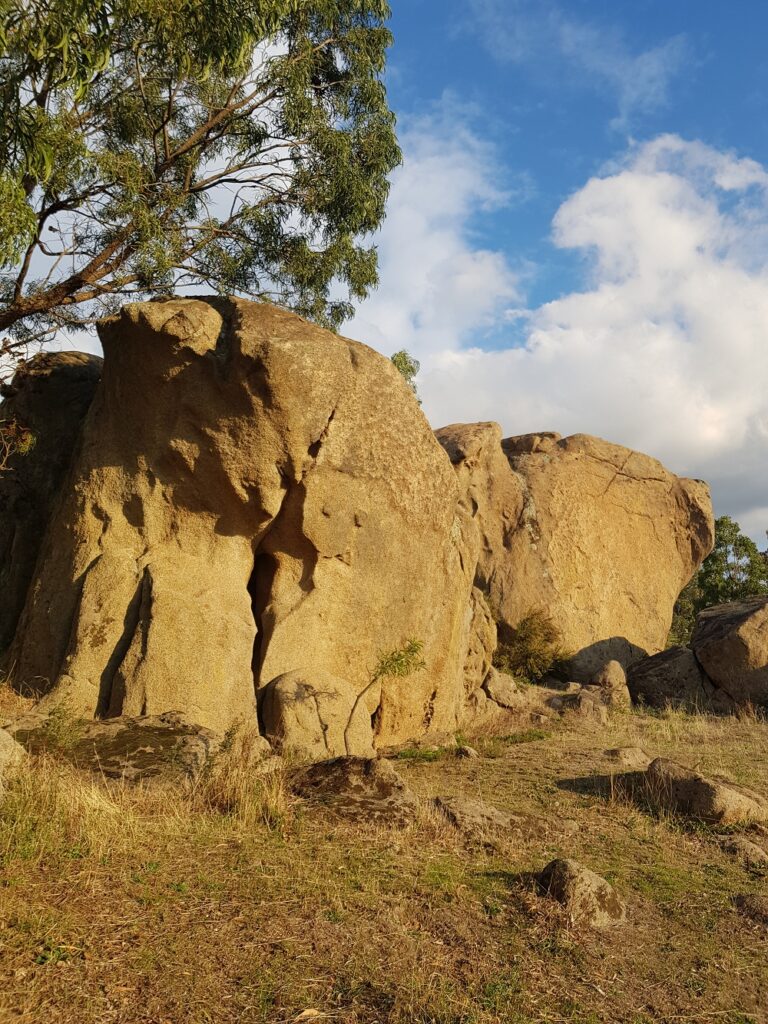
Things that shouldn’t be there
Less inspiring is the amount of feral and invasive flora and fauna we come across in walks on our beautiful mountain, like this herd of feral goats.
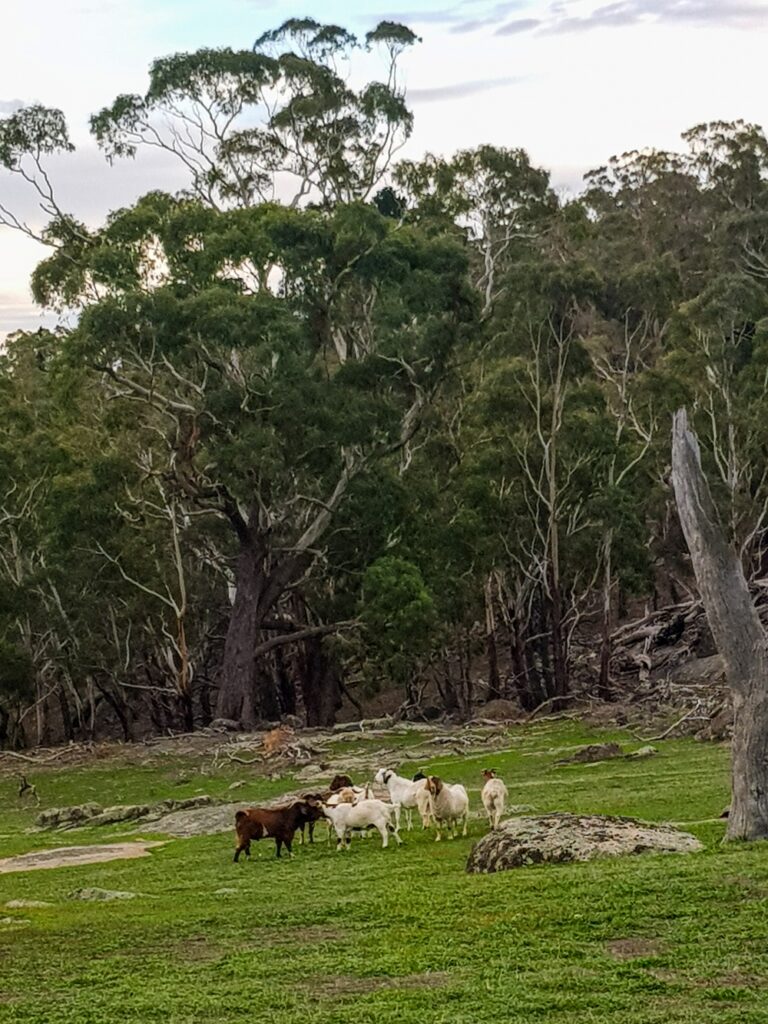
As beautiful and useful as goats are as animals, they need managing. They can even be quite good companions to fruit trees if they’re managed properly.
This lot has escaped from a farm somewhere (they have eartags) and taken up residence on the mountain. They go wherever they want, eat whatever they want, and seem to be breeding at an alarming rate.
This is a fragile and arid landscape, which has evolved with our native animals like kangaroos. While we’ve fenced to keep kangaroos off our farm (where they annoy us by competing for grass with the cows and damaging fruit trees), this is their land. They are perfectly evolved to live harmoniously here in the bush.
We kind of figure it’s up to us to exclude them from the farm, not try to get rid of them altogether, so kangaroo fencing is definitely the solution.
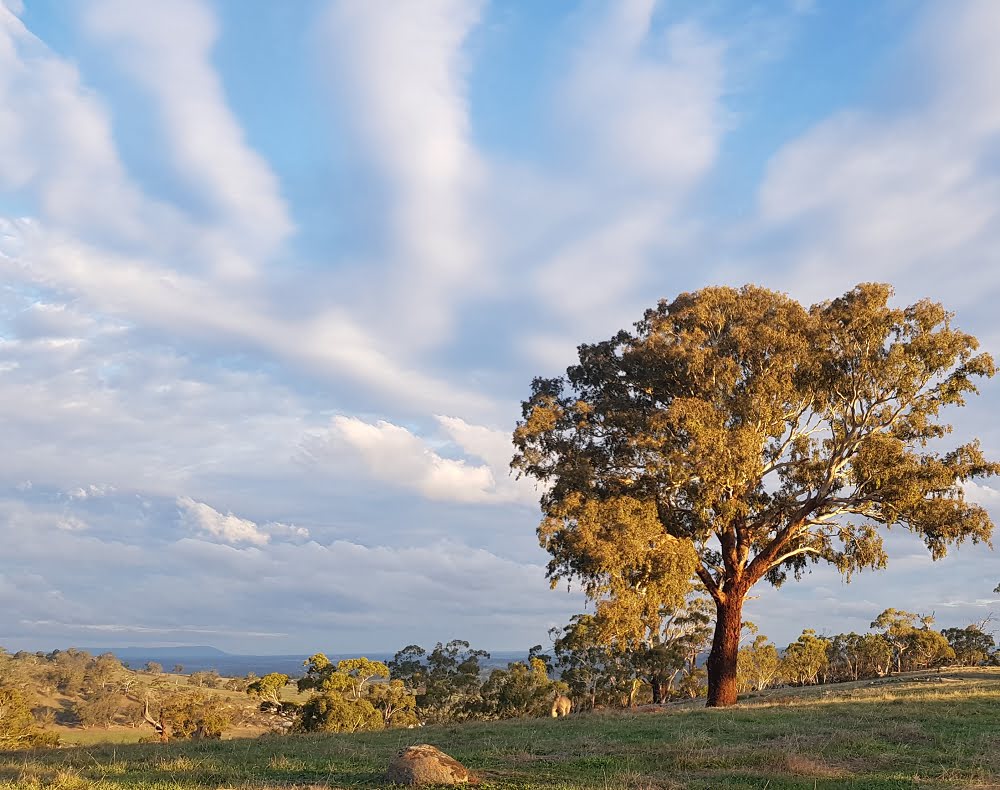
In the meantime, when we’re walking in their patch, we’re perfectly happy to admire them from a distance, and let them be!
Katie Finlay
Grow Great Fruit
Healthy Landscapes guide – purchase a copy now
Posted on 10 March, 2022 by Ivan
We are excited to announce that we have now sold over 120 copies of our Healthy Landscapes guide. If you don’t have one yet, be sure to get your copy before the first print run sells out! They are a bargain at just $15 and perfect for people new to the region, or anyone who wants to learn more about how to protect and restore habitat for our local wildlife. Proceeds allow us to cover printing and administration costs, and support our work.
Here’s just some of the feedback:
- I was in Castlemaine today and suddenly remembered this item about the book being available at Stonemans. They had it at the front desk and we are reading it now back at home. It is really outstanding and very relevant. Thanks to Connecting Country for their dedication. (Welshmans Reef landholder)
- Sensational! A must-read for anyone with a property from 1 to 1,000 acres. (Yapeen landholder/farmer)
- I wish we’d had this guide when I first moved here 25 years ago. (Golden Point landholder)
- Wow, what a fabulous publication. It covers all bases and is an essential read for all landowners. It has particular relevance for anyone doing due diligence before purchasing rural acreage, however big or small. (Walmer landholder)
For more information about the Healthy Landscapes guide – click here
Copies are now on sale – when COVID-19 related restrictions allow.

To get your copy ($15) head to:
Mount Alexander Animal Welfare (MAAW) Op Shop
12 Johnstone St, Castlemaine VIC
For shop information and opening hours – click here
Castlemaine Visitor Information Centre
44 Mostyn St, Castlemaine VIC
For centre information – click here
Stoneman’s Bookroom
101 Mostyn St, Castlemaine VIC
For shop information – click here
The Book Wolf
1/26 High St, Maldon VIC
For shop information – click here
Castlemaine Vintage Bazaar
The Mill, 1-9 Walker St Castlemaine, VIC
For shop information and hours – click here
A copy of the guide has been made available free of charge to each local Landcare and environmental volunteering group in the Mount Alexander region. This project is made possible through support from the Department of Agriculture, Water and the Environment, through funding from Australian Government’s National Landcare Program.
Help the Fryerstown Grevillea with a new app
Posted on 3 March, 2022 by Hadley Cole
The Threatened Species Conservancy has teamed up with John Walter from Malmsbury Landcare Group to develop a mobile phone app to capture and save data on populations of the threatened species, the Fryerstown Grevillea (Grevillea obtecta). Please read on for more information from the Threatened Species Conservancy.
Threatened Species Conservancy app for the Fryerstown Grevillea
The app will be launched on 12 March 2022 at 1.30 pm at the Lauriston Hall in Lauriston, VIC.
A training session will be held and participants will learn how to download and use the app, and visit a nearby population in both Lauriston Forest Reserve and in the Fryers Ranges Reserve.
The Fryerstown Grevillea (Grevillea obtecta) is generally found in the Fryers Ranges from around Taradale south west to the Porcupine Ridge area in central Victoria. The Lauriston population is an isolated and unusual form. It flowers from around mid-October to mid-November. However, it is easily recognised by its unusual leaves at any time of the year. The somewhat similar species, G. repens, also a rare Grevillea, is generally found to the west of Hepburn Springs and to the west and south of Daylesford.
John Walter has been observing this species now for over 20 years. With the help of the new app, observers of Grevillea obtecta – the Fryerstown Grevillea, can now record population locations and help build the knowledge base about this species.

For more information or to register for this event – click here
Connecting Country congratulates John and the Threatened Species Conservancy team on their fantastic achievement that will contribute to valuable data on our precious local threatened species!
Clean Up Australia Day – Sunday 6 March 2022
Posted on 3 March, 2022 by Ivan
Clean Up Australia is happening this Sunday 6 March 2022, including eight locations across the Mount Alexander region. Clean Up Australia inspires and empowers communities to clean up, fix up and conserve our environment. What was started 31 years ago, by an ‘average Australian bloke’ who had a simple idea to make a difference in his own backyard, has now become the nation’s largest community-based environmental event.

Local Clean Up Australia Day working bees on Sunday 6 March include:
- Friends of Campbells Creek Landcare – Meet at Winters Flat footbridge from 8.00 to 10.00 am. For more information – click here
- Golden Point Landcare – Expedition Pass Reservoir from 10.00 am to 12.00 noon. Bring gloves, bags provided. For more information contact Jen Pryce (ph: 0423900 590).
- Sutton Grange Landcare Group – Meet at Sutton Grange Hall at 9.00 am. For more information contact Zane Tronson (ph: 0410 597 485).
To view a map of Clean Up Australia Day working bees across the country, allowing you to search via postcodes and townships – click here

Rubbish dumped at Muckleford Bushland Reserve (photo by Muckleford Catchment Landcare Group)
Tiny houses for Tuans: Seeking YOUR help to combat a wildlife housing crisis
Posted on 2 March, 2022 by Jess
We all know how difficult it can be to secure housing in (or around) Castlemaine right now! But did you know it’s not just people facing a housing crisis in the Mount Alexander area? Many native birds and mammals need tree hollows as homes to protect them from predators and raise their families.
Missing tree hollows
The Mount Alexander region of central Victoria has a long history of removing large old trees with hollows for gold mining, agriculture, and timber and firewood harvesting, leading to a housing crisis for our wildlife. In Australia, it can take hundreds of years for trees to form natural hollows. Due to the profound environmental change caused by European colonisation and the gold rush, many trees in our region are still young. Regrowth and revegetation are great, but they can’t readily replace the number and types of tree hollows that our wildlife desperately need to survive.
The Brush-tailed Phascogale
The Tuan (also known as the Brush-tailed Phascogale) is a very cute hollow-dependent marsupial carnivore that can easily be identified by its characteristic black brushy tail. Phascogales eat mainly invertebrates, and forage for food on and under the bark of trees, on logs, and in leaf litter on the ground. They have an extraordinary life history – all males die from stress following their first breeding season before they reach one year of age. This threatened species is in decline in Victoria and has undergone substantial range contractions and regional extinctions. Key threats include predation by cats and foxes, climate change and drought, habitat removal and degradation, and the extensive loss of trees with hollows. Recent research has highlighted that the Mount Alexander region is a stronghold for tuans and is important for the future conservation of this species.
Our nest box program
In 2010, Connecting Country installed 450 high-quality, specially-designed phascogale nest boxes (effectively, ‘tiny houses’) across 150 sites in the Mount Alexander region. We have an amazing team of skilled, hardworking volunteers who now monitor at least a subset (300) of these nest boxes frequently. Monitoring results indicate that small native marsupials perceive our nest boxes as valuable to provide shelter from predators and to rear their young. At least 150 nest boxes (35%) have had evidence of use by tuans. Another native animal, Krefft’s glider (formerly known as the Sugar Glider) uses our nest boxes too – nearly 90% of our nest boxes have been used by this species at some stage since 2010. Our monitoring program is robust. Thanks to a collaboration with scientists from La Trobe University, the results of our study were recently accepted for publication in the international scientific journal Wildlife Research.
We purchase high-quality nest boxes from Wildlife Nestboxes, a local business based in Castlemaine. These are thoughtfully designed: made with high-quality plywood, a sloping roof to keep the rain out, and have an entrance that is just large enough for a tuan to use, while keeping predators out.
Nest box maintenance
Unlike natural tree hollows, nest boxes typically have a shorter useful life of 5-20 years. They are exposed to the elements, and inevitably degrade and need replacing and maintenance over time. During our last survey in autumn 2021, 96 nest boxes required maintenance of some kind. Several volunteers raised concerns about this and expressed enthusiasm to replace or repair nest boxes, with one volunteer commenting: ‘it just makes me so sad to think that all these nest boxes are not able to be used by phascogales’. Based on expert advice, the most efficient and safe approach is to swap broken nest boxes with a new one on-site, then repair broken nest boxes (where possible) at a workshop at a later date. The repaired nest boxes can then be re-installed when another box eventually degrades.
Nest box monitoring 2022
In partnership with our volunteers, private landholders and Landcare groups, and thanks to a generous grant from the WIRES national grant program, volunteers will monitor nest box sites again in autumn 2022. This provides an ideal opportunity for us to replace broken nest boxes. We are very grateful to landholders and Landcare groups involved in the program who allow site access, to our volunteers for contributing their expertise and time to monitoring our nest boxes. We also acknowledge WIRES for providing funding to help us keep our volunteers safe, well-equipped and supported, and carefully collate and report on our data. We are extremely proud of this project, and this year, we believe a small additional investment will go a long way to provide homes for wildlife.
We are reaching out to our community for support to purchase new nest boxes and provide new, safe, tiny houses for Tuans.
Buy a nest box to provide ‘Tiny houses for Tuans’
Donating to our ‘Tiny Houses for Tuans’ campaign provides excellent value for your investment:
- 100% of funds donated to this project will be spent directly on nest boxes and their installation – providing a brand-new, high-quality, tiny home for a marsupial. We already have the resources to manage the project and install the nest boxes.
- One high-quality nest box costs $100, and we are seeking a total of $6, 000 to replace 60 broken nest boxes. Any additional donations will be used to repair broken nest boxes, and to replace nest boxes that wear out in future.
- Nest boxes will be installed by volunteers at the same time as they are visiting the sites for monitoring, making this a highly-efficient project.
- As we are purchasing from Wildlife Nestboxes, funds will support a local small business.
- Replacing broken nest boxes will bring joy to project participants: skilled volunteers, landholders, associated Landcare groups, and staff, many of whom care deeply about phascogales and their conservation.
- Our 12 year track record demonstrates the value of nest boxes in providing supplementary habitat and a monitoring tool.
Donate today via our Give Now page – click here
We have a secure only payment system and all donations (>$2) to Connecting Country are tax deductible.
Can’t donate? Here are some other ways you can help threatened tuans:
- Keep pets, especially cats (known predators of phascogales), indoors at night when tuans are active
- Retain leaf litter, logs, and trees (especially mature trees) on your property, as these provide foraging and den resources for tuans
- Provide your own ‘Tiny Houses’ – consider installing nest boxes on your property
- Contribute to restoring healthy forests by joining your local Landcare or Friends group. To find a group – click here
- Consider volunteering on Connecting Country’s monitoring project (next surveys in autumn 2022) – email jess@connectingcountry.org.au to register your interest
- Share our campaign with your friends and networks.
